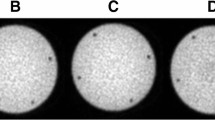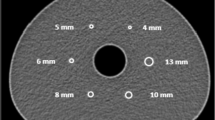Abstract
Whereas Monte Carlo (MC) simulation is widely utilized in estimation of the scatter component, a simulation model which can calculate the scatter fraction (SF) of each patient is needed for making an accurate image quality assessment for clinical PET images based on the noise equivalent count. In this study, an MC simulation model was constructed which can calculate the SF for various phantoms. We utilized the Geant4 toolkit based on MC simulation to make a model of a PET scanner with a scatter phantom, and SFs calculated with this model were compared with the SF (SFconstant: 44%) measured with use of an actual PET scanner. Additionally, the SF values for an anthropomorphic phantom were calculated from its voxel phantom. Furthermore, we evaluated the impact on the SF due to the difference in the source distribution inside the phantom. The SF calculated from the scatter phantom in the MC simulation was 44%, the same as the SFconstant value. The average SF for the anthropomorphic phantom was 41%, but there was a maximum of 14 percentage points difference between each scan range, and the maximum difference in the SF was 8 percentage points for the difference in the source distribution. We constructed an MC simulation model which can calculate SFs for various phantoms. The SF was confirmed to be affected significantly by the source distribution. We judged that the actually measured SFconstant obtained from the PET scanner with the scatter phantom was not suitable for the assessment of the quality of all patient images.







Similar content being viewed by others
References
Strother SC, Casey ME, Hoffman EJ. Measuring PET scanner sensitivity: relating count rates to image signal-to-noise ratios using noise equivalent counts. IEEE Trans Nucl Sci. 1990;37:783–8.
Adam LE, Karp JS, Daube-Witherspoon ME, Smith RJ. Performance of a whole-body PET scanner using curve-plate NaI(Tl) detectors. J Nucl Med. 2001;42:1821–30.
Watson CC, Casey ME, Beyer T, Bruckbauer T, Townsend DW, Brasse D. Evaluation of clinical PET count rate performance. IEEE Trans Nucl Sci. 2003;50:1379–85.
Lartizien C, Comtat C, Kinahan PE, Ferreira N, Bendriem B, Trebossen R. Optimization of injected dose based on noise equivalent count rates for 2- and 3-dimensional whole-body PET. J Nucl Med. 2002;43:1268–78.
Visvikis D, Fryer T, Downey S. Optimisation of noise equivalent count rates for brain and body FDG imaging using gamma camera PET. IEEE Trans Nucl Sci. 1999;46:624–30.
Dekemp R, Caldwell C, Farncombe T, Mckee B, Wassenaar R, Wells R, et al. PET imaging standards and quality assurance for the multi-center trials of the Ontario Clinical Oncology Group (OCOG). J Nucl Med Meet Abstr. 2006;47:365.
Mizuta T, Senda M, Okamura T, Kitamura K, Inaoka Y, Takahashi M, et al. NEC density and liver ROI S/N ratio for image quality control of whole-body FDG-PET scans: comparison with visual assessment. Mol Imaging Biol. 2009;11:480–6.
Fukukita H, Suzuki K, Matsumoto K, Terauchi T, Daisaki H, Ikari Y, et al. Japanese guideline for the oncology FDG-PET/CT data acquisition protocol: synopsis of Version 2.0. Ann Nucl Med. 2014;28:693–705.
Murayama H. Radiation detectors in positron emission tomography. Med Imaging Technol. 2000;18:15–23 (in Japanese with English abstract).
Barton JB, Hoffman EJ, Iwanczyk JS, Dabrowski AJ, Kusmiss JH. A high resolution detection system for positron tomography. IEEE Trans Nucl Sci. 1983;30:671–5.
Tarantola G, Zito F, Gerundini P. PET instrumentation and reconstruction algorithms in whole-body applications. J Nucl Med. 2003;44:756–69.
National Electrical Measurements Association. Performance measurements of positron emission tomographs. NEMA Standards Publication NU 2-2007. Rosslyn: NEMA; 2007.
Wagatsuma K, Miwa K, Miyaji N, Murata T, Umeda T, Osawa A, et al. Comparison of (18)F-fluoro-2-deoxy-d-glucose positron emission tomography/computed tomography image quality between commercial and in-house supply of FDG radiopharmaceuticals. Jap J Radiol Technol. 2014;70:339–45 (in Japanese with English abstract).
Shimada N, Daisaki H, Murano T, Terauchi T, Shinohara H, Moriyama N. Optimization of the scan time is based on the physical index in FDG-PET/CT. Jpn J Radiol Technol. 2011;67:1259–66 (in Japanese with English abstract).
Brasse D, Tararine M, Lamer O, Bendriem B. Investigation of noise equivalent count rate in positron imaging using a dual head gamma camera. IEEE Trans Nucl Sci. 1998;45:438–42.
Surti S, Kuhn A, Werner ME, Perkins AE, Kolthammer J, Karp JS. Performance of Philips Gemini TF PET/CT scanner with special consideration for its time-of-flight imaging capabilities. J Nucl Med. 2007;48:471–80.
Zaidi H, Ojha N, Morich M, Griesmer J, Hu Z, Maniawski P, et al. Design and performance evaluation of a whole-body Ingenuity TF PET-MRI system. Phys Med Biol. 2011;56:3091–106.
Osawa A, Miwa K, Wagatsuma K, Takiguchi T, Tamura S, Akimoto K. Relationship between image quality and cross-sectional area of phantom in three-dimensional positron emission tomography scan. Jpn J Radiol Technol. 2012;68:1600–7 (Japanese with English abstract).
Ferrero A, Poon JK, Chaudhari AJ, MacDonald LR, Badawi RD. Effect of object size on scatter fraction estimation methods for PET—a computer simulation study. IEEE Trans Nucl Sci. 2011;58:82–6.
Konik A, Madsen MT, Sunderland JJ. GATE simulations of human and small animal PET for determination of scatter fraction as a function of object size. IEEE Trans Nucl Sci. 2010;57:2558–63.
Constantinescu CC, Mukherjee J. Performance evaluation of an Inveon PET preclinical scanner. Phys Med Biol. 2009;54:2885–99.
Agostinelli S, Allison J, Amako K, Apostolakis J, Araujo H, Arce P, et al. Geant4—a simulation toolkit. Nucl Instrum Methods A. 2003;506:250–303.
Allison J, Amako K, Apostolakis J, Araujo H, Dubois PA, Asai M, et al. Geant4 developments and applications. IEEE Trans Nucl Sci. 2006;53:270–8.
Lo Meo S, Cicoria G, Campanella F, Mattozzi M, Panebianco AS, Marengo M. Radiation dose around a PET scanner installation: comparison of Monte Carlo simulations, analytical calculations and experimental results. Phys Med. 2014;30:448–53.
Meo SL, Bennati P, Cinti MN, Lanconelli N, Navarria FL, Pani R, et al. A Geant4 simulation code for simulating optical photons in SPECT scintillation detectors. J Inst. 2009;. doi:10.1088/1748-0221/4/07/P07002.
Schneider W, Bortfeld T, Schlegel W. Correlation between CT numbers and tissue parameters needed for Monte Carlo simulations of clinical dose distributions. Phys Med Biol. 2000;45:459–78.
Daube-Witherspoon ME, Karp JS, Casey ME, DiFilippo FP, Hines H, Muehllehner G, et al. PET performance measurements using the NEMA NU 2-2001 standard. J Nucl Med. 2002;43:1398–409.
Daube-Witherspoon ME, Muehllehner G. Treatment of axial data in three-dimensional PET. J Nucl Med. 1987;28:1717–24.
International Committee on Radiation Units and Measurements. Photon, electron, proton, and neutron interaction data for body tissues (ICRU Report 46), Bethesda; 1992.
Ay MR, Sarkar S. Computed tomography based attenuation correction in PET/CT: principles, instrumentation, protocols, artifacts and future trends. Iran J Nucl Med. 2007;15:1–29.
Watson CC, Casey ME, Bendriem B, Carney JP, Townsend DW, Eberl S, et al. Optimizing injected dose in clinical PET by accurately modeling the counting-rate response functions specific to individual patient scans. J Nucl Med. 2005;46:1825–34.
Oka R, Miura K, Sakurai M, Nakamura K, Yagi K, Miyamoto S, et al. Impacts of visceral adipose tissue and subcutaneous adipose tissue on metabolic risk factors in middle-aged Japanese. Obesity. 2010;18:153–60.
Author information
Authors and Affiliations
Corresponding author
Ethics declarations
Ethical approval
This article does not contain any studies with human participants or animals performed by any of the authors.
Conflict of interest
The authors declare that they have no conflict of interest.
About this article
Cite this article
Hosokawa, S., Inoue, K., Kano, D. et al. A simulation study for estimating scatter fraction in whole-body 18F-FDG PET/CT. Radiol Phys Technol 10, 204–212 (2017). https://doi.org/10.1007/s12194-016-0386-x
Received:
Revised:
Accepted:
Published:
Issue Date:
DOI: https://doi.org/10.1007/s12194-016-0386-x




